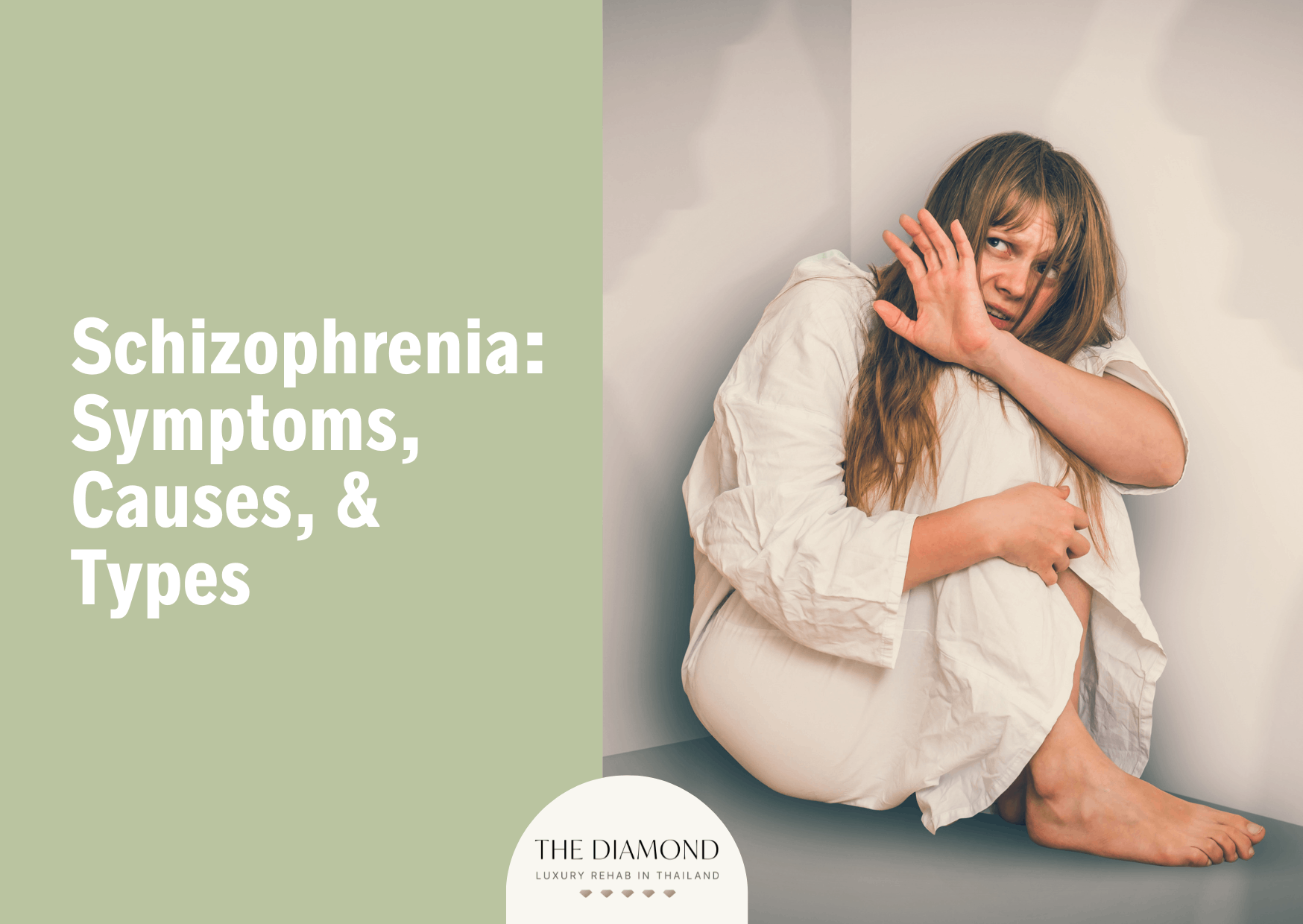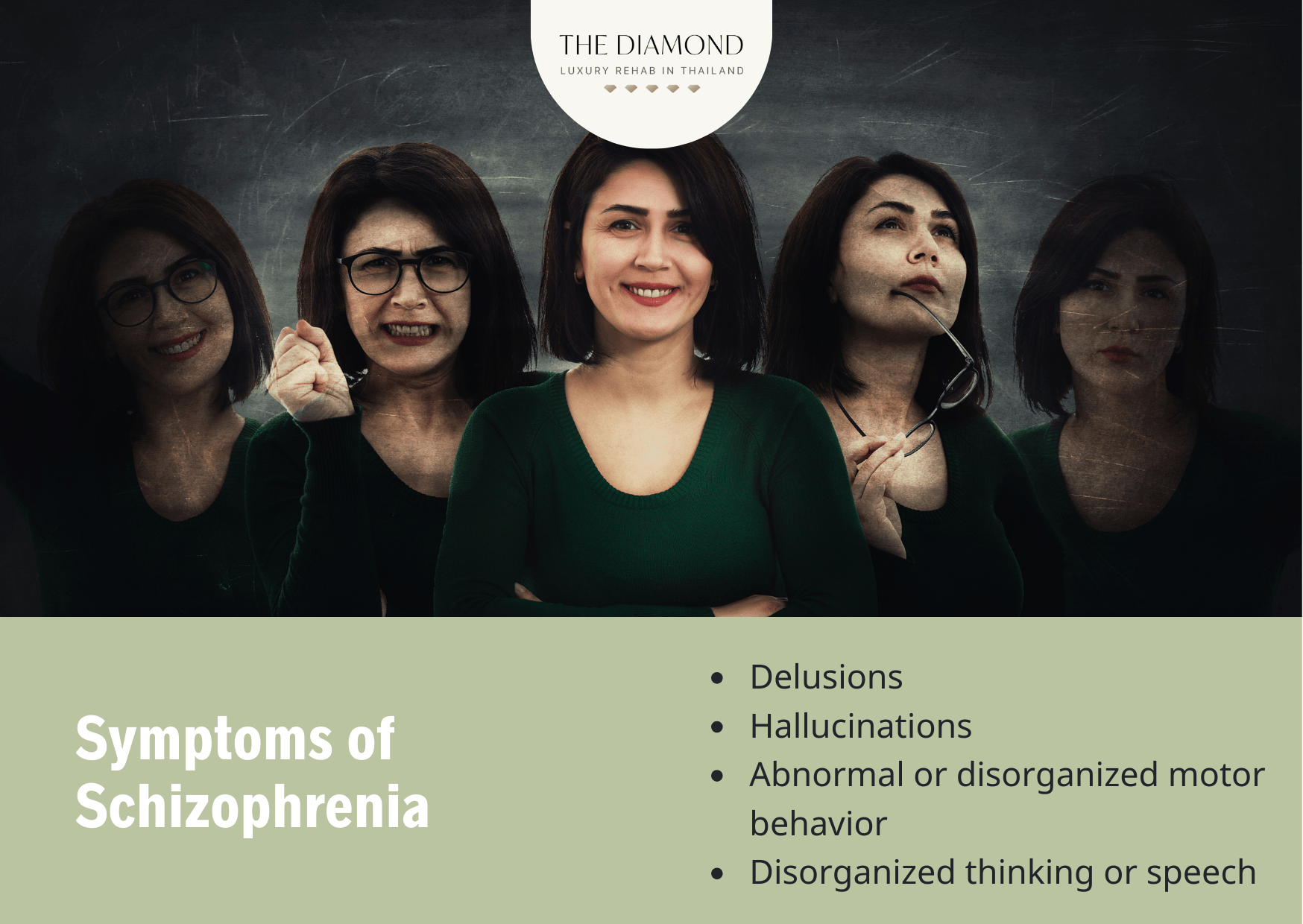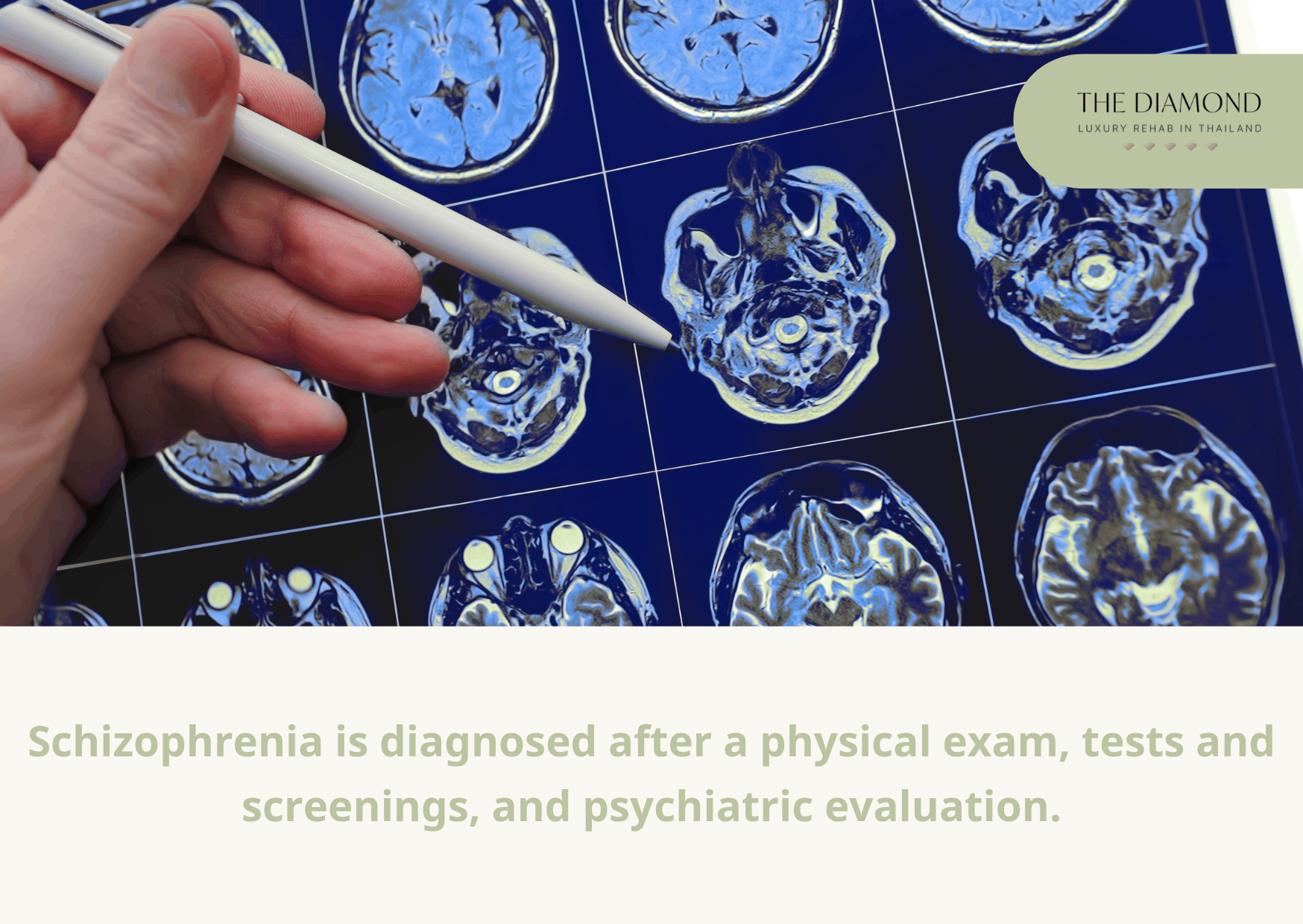Schizophrenia: symptoms, causes, and types

Schizophrenia is a serious mental health disorder where people have an abnormal understanding of reality. It is a lifelong condition, but it is possible to have it managed and put under control. Schizophrenia is uncommon compared to other mental illnesses, such as anxiety and depression.
The most prominent signs and symptoms of schizophrenia include delusions, hallucinations, abnormal or disorganized motor behavior, disorganized speech or thoughts, and negative symptoms like the absence of personal hygiene.
The causes of schizophrenia aren’t entirely clear. In most cases, a combination of genetics, brain structure and chemistry, and environment plays a role. The mental disorder has a strong genetic component, but little is known about specific genes that contribute to its development.
There are different types of schizophrenia. At one point, in the Diagnostic and Statistical Manual of Mental Disorders, fourth edition (DSM-4), several types of schizophrenia have been described. These included paranoid, catatonic, disorganized, residual, and undifferentiated schizophrenia.
However, DSM-5 removed those types and shifted focus to the most prominent symptoms in each patient. In addition, the DSM-5 included disorders that are related to or resemble certain aspects of schizophrenia.
These disorders include schizotypal personality disorder, delusional disorder, brief psychotic disorder, schizophreniform disorder, schizoaffective disorder, substance- or medication-induced psychotic disorder, and psychotic disorder due to another medical condition.
What is Schizophrenia?
Schizophrenia is a mental disorder indicated by the abnormal perception of reality. It involves distortions in thought process, perception, social interactions, and emotional responsiveness. While the course of this psychiatric disorder varies among patients, schizophrenia is usually persistent. It tends to be severe and disabling.
Schizophrenia is recognized as a mental health disorder by the American Psychiatric Association’s Diagnostic and Statistical Manual of Mental Disorders, fifth edition (DSM-5). It has been a part of DSM since the first edition.
Over the years definitions, criteria, and types of schizophrenia have changed. Schizophrenia is additionally described by the World Health Organization’s International Classification of Disease, the eleventh revision (ICD-11), and its predecessors.
The term schizophrenia is about 100 years old. It was coined by Swiss psychiatrist Eugen Bleuler to describe a separation of function between perception, thinking, memory, and personality. A German psychiatrist, Dr. Emil Kraepelin, was the first person to identify schizophrenia back in 1887. However, it is generally believed schizophrenia has been around since ancient times.
Generally speaking, schizophrenia is usually diagnosed in late adolescence to early thirties. Men tend to develop schizophrenia earlier than women. For example, men tend to develop this mental disorder in their late twenties, whereas women usually get it in their early thirties.
While symptoms start in late adolescence or early adulthood, schizophrenia is often considered from a developmental perspective. Unusual behaviors and cognitive impairment appear in childhood.
Schizophrenia consists of three stages with distinct symptoms and which tend to overlap, including prodromal, active, and residual. The prodromal stage is the first stage of schizophrenia; it occurs before the appearance of noticeable psychotic symptoms. During this time, a patient experiences cognitive and behavioral changes that eventually lead to psychosis.
In the active stage, patients experience the classic symptoms of schizophrenia, such as delusions. While the residual stage isn’t recognized anymore, healthcare providers still refer to it to describe symptoms of schizophrenia. Basically, this phase involves reduced severity and frequency of symptoms from the active stage.
A common misconception is that people with schizophrenia have multiple personalities. While they have delusions and hallucinations, patients with schizophrenia don’t have multiple personalities.
How common is Schizophrenia?
Schizophrenia isn’t as common as other mental health disorders. A 2022 fact sheet titled, “Schizophrenia” from the World Health Organization (WHO) revealed that 24 million people in the world have schizophrenia. In other words, this psychiatric disorder affects one in 300 people, or 0.32% of the general population, or one in 222 (0.45%) adults.
In the United States, the adult population has an annual prevalence of schizophrenia that is below 1%, according to a publication titled, “Mental Health By the Numbers” last updated in April 2023 by the National Alliance on Mental Illness.
More precise prevalence is reported by the National Institute of Mental Health’s article titled, “Schizophrenia” set to expire in June 2024, which revealed that schizophrenia and related psychotic disorders affect between 0.25% and 0.64% of adults in the U.S.
Information about the gender prevalence of schizophrenia is scarce. A 2023 statistic titled, “Percentage of the U.S. population with schizophrenia from 1990 to 2019, by gender” from Statista reported that as of 2019, around 0.46% of U.S. women and 0.48% of men had been diagnosed with schizophrenia. That means this mental health disorder is more common in males than females.
When it comes to children and adolescents, schizophrenia is rare. A 2011 paper by Gochman et al., published in Current Psychiatry Reports revealed that childhood-onset schizophrenia affects one in 40,000 children.
Meanwhile, schizophrenia exhibits a substantial increase in prevalence during adolescence, with an estimated 0.23% occurring between the ages of 13 and 18, as per a 2012 review by Ch Androutsos published in the journal Psychiatriki.Finally, a 2009 article by Rosenberg et al., published in the Annals of Long-Term Care stated that in individuals 45–64 years old, the prevalence of schizophrenia is roughly 0.6%; in those 65 and beyond, it varies from 0.1% to 0.5%.
What are the symptoms of Schizophrenia?

Symptoms of schizophrenia include problems with behavior, emotions, and cognition. Although they vary in type and severity, the most common signs and symptoms of schizophrenia are listed below.
- Delusions: false beliefs, i.e. beliefs that aren’t based on reality
- Hallucinations: hearing or seeing things that don’t exist. While hallucinations affect all senses, they usually appear in the form of hearing voices.
- Abnormal or disorganized motor behavior: inappropriate or bizarre posture, complete lack of response, refusing to follow instructions, excessive or useless movement, etc.
- Disorganized thinking or speech: impaired communication, giving unrelated answers to questions, putting together meaningless words that are difficult to understand
- Negative symptoms: absence of normal functioning such as neglecting personal hygiene, lacking emotion, losing interest in everyday activities, and social isolation.
What causes Schizophrenia?
While it is not entirely clear what causes schizophrenia, the psychiatric disorder potentially develops due to a combination of factors. The causes of schizophrenia are listed below.
- Genetics: Heredity or genetic predisposition plays a significant role in the development of schizophrenia, but no single gene is responsible for this condition. Different combinations of genes make people more susceptible to developing schizophrenia. A 2017 paper by Henriksen et al., from Frontiers in Human Neuroscience reported that children of twins with schizophrenia were more likely to develop this psychiatric disorder than children of healthy twins. Pre-molecular and molecular genetics have confirmed beyond doubt that genetic predisposition is among the causes of schizophrenia. A lot more research on this subject is necessary, especially when it comes to specific genes that carry the risk. A useful thing to keep in mind is that carrying certain genes doesn’t automatically indicate a person is going to develop schizophrenia. Instead, it means there is a possibility.
- Brain structure and chemistry: People with schizophrenia have an imbalance of neurotransmitters dopamine, glutamate, and serotonin. These brain chemicals allow neurons to send messages to one another. More precisely, they carry the messages along brain pathways that regulate perception, thinking, and motivation. The impaired balance of these neurotransmitters affects how the brain reacts to stimuli, which explains why patients with schizophrenia tend to be overwhelmed by sensory information such as bright lights or loud noises. Besides chemistry, changes in brain structure are involved in the development of schizophrenia as well. A study by Karlsgodt et al., published in the August 2010 issue of Current Directions in Psychological Science stated that schizophrenia is linked to alterations in the structure and operation of several crucial brain systems, such as the prefrontal and medial temporal lobe regions that are responsible for working memory and declarative memory, respectively.
- Environment: Environmental exposures, including nutritional deficits, infections, and neurotoxins, contribute to the development of various neuropsychiatric disorders. They additionally play a role in the onset of schizophrenia. A 2011 paper by Alan S. Brown from the journal Progress in Neurobiology stated that according to recent research, environmental exposures may play a bigger part in the onset of schizophrenia than previously believed.
What are the types of Schizophrenia?
Different types of schizophrenia show the true severity of the disorder that affects people differently. Classification of schizophrenia is different in DSM-4 and DSM-5. While DSM-4 identifies several types of schizophrenia specifically, DSM-5 focuses on key symptoms in each patient. Also, DSM-5 lists schizophrenia alongside some conditions that fall into the group of schizophrenia spectrum and psychotic disorders. Types of schizophrenia are demonstrated in the table below.
| DSM-4 | DSM-5 | ||
| Type of schizophrenia | Description | Schizophrenia-related disorder | Description |
| Catatonic type | Catatonia is the main element of this condition. It is a syndrome that induces abnormal behaviors, physical movements, and withdrawal. Persons with catatonic schizophrenia also displayed symptoms such as mutism, depression, mania, or psychosis, echopraxia (mimicking other people’s actions), and echolalia (repeating someone’s words). It was necessary to experience at least two symptoms of catatonia to be diagnosed with this type of schizophrenia. | Schizotypal personality disorder | Characterized by a consistent pattern of intense discomfort with relationships and social interactions. Patients tend to have unusual thoughts, eccentric behaviors, and speech. |
| Paranoid type | Characterized by a preoccupation with one or more delusions or auditory hallucinations. Persons with paranoid type schizophrenia also have symptoms such as disorganized speech and behavior, and lack of emotional response, but these symptoms aren’t prominent. | Delusional disorder | The main symptom is the presence of one or more delusions. No psychotic symptoms are present, however. |
| Disorganized type | Indicated by disorganized speech and behavior, as well as lack of or inadequate emotional response. In order to be diagnosed with disorganized type, a patient’s condition couldn’t be explained by catatonic schizophrenia. | Brief psychotic disorder | A short-term disturbance characterized by the sudden onset of at least one psychotic symptom. It lasts longer than a day, but less than a month. |
| Residual type | Characterized by the absence of prominent hallucinations, delusions, catatonia, and disorganization. Patients demonstrated continuing disturbance with the presence of two or more symptoms that are generally mild. | Schizophreniform disorder | Like schizophrenia, it affects cognition, behavior, emotions, and communication. However, it lasts one to six months only. |
| Undifferentiated type | Including symptoms that didn’t fit into other types of schizophrenia. | Schizoaffective disorder | Indicated by a combination of schizophrenia symptoms and mood disorder symptoms. |
| Substance- or medication-induced psychotic disorder | A psychotic disorder arises from the use of prescription medications, alcohol, and illicit drugs. | ||
| Psychotic disorder due to another medical condition | Cases when psychosis occurs due to untreated medical conditions such as autoimmune conditions, endocrine, and metabolic diseases, and temporal lobe epilepsy. | ||
What are the risk factors of Schizophrenia?
Risk factors for schizophrenia are characteristics or circumstances that increase the likelihood of an individual developing the complex condition. The risk factors for schizophrenia are listed below.
- Family history of schizophrenia
- Taking psychoactive or psychotropic (mind-altering) drugs in adolescence and young adulthood
- Pregnancy and birth complications such as malnutrition and exposure to toxins and viruses that affect brain development
- Living in a densely populated area
- Living in poverty or dangerous surroundings
- Psychological stress
- Traumatic or life-changing events
How is Schizophrenia diagnosed?

Schizophrenia is diagnosed after a physical exam, tests and screenings, and psychiatric evaluation. A great deal of diagnostic processes accounts for eliminating other mental health disorders and determining that symptoms of schizophrenia aren’t consequences of addiction.
The main objective of the physical exam is to rule out other health problems that are potentially causing a patient’s symptoms. The doctor is likely to order several tests such as screening for drugs or alcohol and imaging tests like MRI and CT. These tests are meant to confirm that no physical health problem is behind the symptoms a person experiences.
Psychiatric evaluation is the cornerstone of the diagnostic process. During this exam, a healthcare professional evaluates a patient’s mental status by observing their appearance and demeanor. Patients need to answer questions about delusions, thoughts, moods, hallucinations, the potential for violence and suicide, and substance abuse. In addition, a healthcare provider is likely to discuss family and personal history with a patient. To confirm the diagnosis, a healthcare professional uses the criteria for schizophrenia as listed in the DSM-5. According to DSM-5, criteria for schizophrenia diagnosis include having at least two of five main symptoms, social or occupational dysfunction, and length of symptoms. Diagnosis of schizophrenia further implies that the key symptoms need to last at least one month, and the condition’s effects need to last for at least six months.
How long does Schizophrenia last?
Schizophrenia is a lifelong mental health disorder, but it is possible to manage its symptoms. The duration of the active phase of schizophrenia ranges from several years to a decade, according to an article titled, “Schizophrenia Prognosis” medically reviewed in April 2022 from WebMD. Most people fully recover to the point that they’re able to work and live on their own. The social occupational functions improve within six months after starting the treatment.
What are the available treatments for Schizophrenia?
Available treatments for schizophrenia depend on the symptoms and the severity of the condition, but usually rely on a combination of approaches. The available treatments for schizophrenia are listed below.
- Cognitive-behavioral therapy
- Medications

1. Cognitive behavioral therapy
Cognitive-behavioral therapy (CBT) is a type of psychotherapy that aids the management of mental health problems by changing the way patients think and behave. The structured and time-limited type of therapy works by helping patients become aware of negative or inaccurate thinking.
That way, patients view their situation more clearly and respond to negative stimuli or irrational thoughts in a healthier manner. In patients with schizophrenia, the main goal of CBT is to normalize thought patterns and help cope with stress.
Basically, the purpose of CBT isn’t to “cure” schizophrenia but to improve a patient’s functioning, manage their condition, and reduce the distress they experience on a daily basis.
A therapist uses several cognitive behavioral therapy approaches for patients with schizophrenia. These include cognitive restructuring, behavioral experiments or reality testing, self-monitoring, and coping skills.
Results from a 2021 study by Shukla et al., published in the Industrial Psychiatry Journal found that CBT combined with medication was found to be more successful in relieving clinical symptoms of schizophrenia and overall functioning than pharmacotherapy alone. Cognitive-behavioral therapy is considered an effective adjunct to medications. Its benefits go beyond treating acute symptoms and extend to addressing persistent symptoms in patients with schizophrenia. Finally, CBT is useful because it manages comorbid conditions such as anxiety and depression.
2. Medications
Medications for schizophrenia refer to pharmaceutical treatments which are an essential component of the overall treatment plan for individuals with schizophrenia. Healthcare providers usually prescribe antipsychotic medications, whose purpose is to act on dopamine to regulate symptoms.
The goal of treatment with antipsychotics is to manage symptoms of schizophrenia at the lowest dose possible. For that purpose, psychiatrists often use different medications, doses, or combinations to achieve the best results.
Once they find the most suitable medications and dosage, it becomes the standard part of the treatment. For the management of schizophrenia, a psychiatrist prescribes anti-anxiety medications or antidepressants to manage a comorbid mental health condition.When it comes to treatment with medications, results aren’t instant. It takes several weeks to notice improvements regarding delusions and hallucinations. Since medications for schizophrenia come with side effects, patients need to adhere to dosage instructions and take the drugs as recommended.
Can stress lead to Schizophrenia?
Yes, stress can lead to schizophrenia. In addition to early neurodevelopmental processes, a 2002 paper by Corcoran et al., from CNS Spectrums explored the idea that gradual neurodegenerative changes driven by postnatal events, such as stress, additionally contribute to the development of schizophrenia.
Stress is a normal, natural response to negative stimuli. While stress is a normal reaction, chronic or unmanaged stress becomes a problem and jeopardizes both physical and psychological health.
Key elements in the stress cascade tend to be abnormal in schizophrenia. These include the stress hormone cortisol, cognition, and hippocampus. The regulation of the hormone cortisol is disrupted in numerous patients with schizophrenia.
The paper added that while stress plays a role in the development of schizophrenia, the link does not always indicate causation.
More precisely, stress is a risk factor for schizophrenia (especially in vulnerable persons), but experiencing stress doesn’t automatically indicate a person is bound to develop this mental health condition. That happens because the development of schizophrenia involves other factors too. Stress hypersensitivity or exposure to substantial stressors during adolescence is likely to start a domino effect resulting in a schizophrenia-like profile in adults.
Is Schizophrenia contagious?
No, schizophrenia isn’t contagious. It can’t spread from one person to another through close contact or cough. Schizophrenia isn’t a viral or bacterial disease. That being said, the disease tends to run in families. Schizophrenia has a genetic component, meaning someone with a family history of this mental health condition is susceptible to developing it as well.

